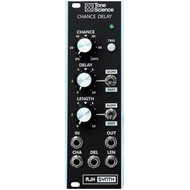Tone Science Chance Delay - AJH Synth
by Evan Morrow
Ian Boddy has played enough shows over the years that if he feels there’s not a module to perform some function or another that he’d like in his rig—enough so that he helps design it—then it’s probably worth paying attention to. There are already chance modules out there to bring a little uncertainty (or human touch, as some call it!) to the clocked and synced griddiness of modular, so what prompted this newest collaboration with AJH Synths for their new Tone Science Chance Delay?
Well, first off, just by looking at the interface with its three controls (Chance, Delay, and Length), it becomes clear that this is a performative module, capable of quick, easy change (and chance!). The main function of Chance Delay is creating both chance and delay (who’d a thunk it?!) to an incoming gate signal, which, depending on the setting, will be seen at the output of the module for—again, depending on the setting—a certain length of time, with a certain amount of delay after the initial gate input. Turn the Chance control from 0-100% and there’s a quick way to add more (or less) probability that you will see that incoming gate signal at the output. Want to tweak the delay setting, the time it takes for the signal to be routed to the output? Turn the Delay. Want to adjust the length of the outgoing gate? You get it, I’m sure. A lot of the modules I’ve run across that have this feature of chance, or have it as part of a larger module, and it requires a bit of bobbing and weaving to get to the correct page or menu. That’s not the case here, and that’s exactly the point. Like I said, quick and easy.
On top of Chance Delay acting at its most basic as a chance delay, it can also stretch a pulse wave so you’re able to turn a pulse into a gate signal (nice!), or vice versa (also nice!), and with the Delay feature it can also be mathematically put into use as a clock divider; although, that’s one of those “bonus” features that are more (to me) “Synth Academy 101,” kind of educational/infomercial style (“But wait! There’s more!), i.e., it’s cool that it can do this on top of its intended functions, but I’m only going to be using it as a delay with chance for those performative functions I want to add this element to. Got it?
With CV inputs for all three parameters where the controls act as an attenuator for the incoming CV signals, if you want to have your hands free while still altering the Chance, Delay, and Length, you can. Patch in some modulation on any of the controls and see what gives, all while giving your hands a rest. Actually, what gives—as as in what Chance Delay gives, at least at the output—is some form of a gate or pulse wave, though if the Length is long enough and you patch in a continuous and time-appropriate gate at the input you could use Chance Delay as an offset as well, supplying a near steady rate of +5V, for more Synth Academy 101.
Both Delay and Length have a total range of 0.5mS to 30 seconds (still waiting!), with each having a Fast/Slow switch where Fast is from 0.5mS to 2 Sec and Slow is from 2 Sec to 30 Sec. There’s also a Trigger button for you manual types, and a green LED to show when the incoming gate is passing to the output, which is a handy visual for what’s on the exit side of the module.
I’ve been using Chance Delay on a lot of different spots in my patches, from feedback amount (essentially as a random bypass since it’s a gate signal—the feedback is either on or off) on the Bastl Basil, using it to trigger an envelope with which to sweep a filter, using it to trigger auxiliary percussion hits with a low probability of chance for that extra occasional bit of flair, and even for opening a VCA to let some plain ol’ noise get through, sitting deep in a dense rhythm patch.
This is a great module, very useful, very fun, and fits well in a performance setup. My only complaint—yes, it’s somewhat common, but here it really holds true—is that it’s only a single channel, as two channels of this would be great. I like being able to program a certain amount of chance in a patch, and most of those chance/random acts of patch modulation in my creations I like to be hands off, controlled by some CV, but when I want to be decidedly hands on, to have a couple of instances where I’m in control, where it’s easy to add or subtract some likelihood of probability and control the length and delay of a gate signal? I’ll be reaching for Chance Delay.
Price: $240
ajhsynth.com


